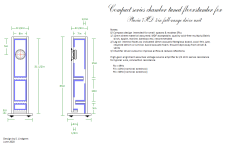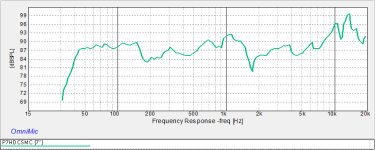It's viable -I designed it, so I'm in a reasonable position to know. It was mostly done for the Japanese market, where multi-chamber loads are quite popular. Strictly speaking it isn't a reflex though as it doesn't use a Thuras style alignment.
Thanks! Any chance there are measured response curves for the design?
I’m excited to build it now.
I’m excited to build it now.
Interesting! Please give us more information/explanation about this design.it isn't a reflex though as it doesn't use a Thuras style alignment.
Any chance there are measured response curves for the design?
Unlikely - it's one of the "opportunities" of using these designs. You might be the first to build it. Or perhaps, the first to build AND measure it!
Have a go and see what it sounds like; that's why most of us are here. You might be interested to scroll through nandappe's posts for measured full range builds.
Why would it be 'unlikely'? Since it's 0319 and I'm on my laptop, I'll have to post the FR tomorrow, as it's on my desktop machine. As noted, it's been quite popular with some builders in Japan.
These things are not just pulled out of the air; the fact that I don't post full measurements of every single design I create doesn't mean they don't exist -it means that muggins here unfortunately doesn't have an infinity of time. If I got into that game, I'd be here (and everywhere else, probably) until the next flood happens. 😉
These things are not just pulled out of the air; the fact that I don't post full measurements of every single design I create doesn't mean they don't exist -it means that muggins here unfortunately doesn't have an infinity of time. If I got into that game, I'd be here (and everywhere else, probably) until the next flood happens. 😉
Last edited:
Perhaps unlikely was unfair phrasing - what I really mean is, resources such as FR charts are not always easily found or able to sourced without explicitly asking for them, or knowing who to ask! And I should speak for myself, not others; the personal experiment of trying a design without really knowing precisely what to expect from its sound - and just being excited about a design, not a chart - is what's fun. I think many would relate to this 🙂
For a project with smaller fullrange / wideband drivers.
The tower form factor seems like the more ideal shape
to just have fun.
The extra space you get from going tall.
Is just asking to have a multi chamber port.
Might as well have fun with the space.
Go for it.
Gives room for being creative with final finish too.
Port has been designed already.
Saves some time, all the works been done.
far as maths and measure.
The tower form factor seems like the more ideal shape
to just have fun.
The extra space you get from going tall.
Is just asking to have a multi chamber port.
Might as well have fun with the space.
Go for it.
Gives room for being creative with final finish too.
Port has been designed already.
Saves some time, all the works been done.
far as maths and measure.
@Scottmoose thanks for seeing and taking the time to respond to this thread. I love the fact that audio guys enjoy sharing. 😎
No, I agree (not unfair at all) -I understand where you're coming from, & you're right, it can be a challenge (or a leap of faith 😉 ) if data isn't posted. Sorry I couldn't add earlier but been out most of the day. This is the quick one from Omnimic I took, 6ms window IIRC. Excuse the graph scale; I've got more detailed plots elsewhere with nearfield hard spliced in that look a bit prettier too, but will need to dig them out of the records & this should give an idea of the general trending.Perhaps unlikely was unfair phrasing - what I really mean is, resources such as FR charts are not always easily found or able to sourced without explicitly asking for them, or knowing who to ask! And I should speak for myself, not others; the personal experiment of trying a design without really knowing precisely what to expect from its sound - and just being excited about a design, not a chart - is what's fun. I think many would relate to this 🙂
Attachments
That’s awesome! Very respectable for a single driver. I’m building these for an office (10x12) so no need for high spls.
Below 150 Hz is impressive flat and very deep for a small fullrange!This is the quick one from Omnimic I took...
Is that dip around 200 Hz coming from the enclosure, or from the room?
measured response curves for the design?
Above the bass tuning, and ignoring diffraction effects the response will only differ in the bass when compared to other P7HD designs.
dave
Below 150 Hz is impressive flat and very deep for a small fullrange!
Is that dip around 200 Hz coming from the enclosure, or from the room?
That is odd because typical response curves for that driver show a rising output as you move from 400hz down to about 120hz.
Below 150 is a result of that ported, three chamber, series resonance. If you look at the dimensions of the chambers heights: 15”, 10”, 5” with the total chambers height of 30”.Below 150 Hz is impressive flat and very deep for a small fullrange!
Is that dip around 200 Hz coming from the enclosure, or from the room?
I’m most likely misspeaking a bit but it is pretty “badass”. 😈
No dsp, no eq, just acoustic wizardry. 😉
Frequency response in the datasheet is measured with the driver mounted on very big flat plane, i.e. without baffle step, so not equal with a driver mounted in a narrow front baffle of the enclosure.That is odd because typical response curves for that driver show a rising output as you move from 400hz down to about 120hz.
- Home
- Loudspeakers
- Full Range
- Pluvia 7.2 HD triple reflex series chamber loudspeaker

